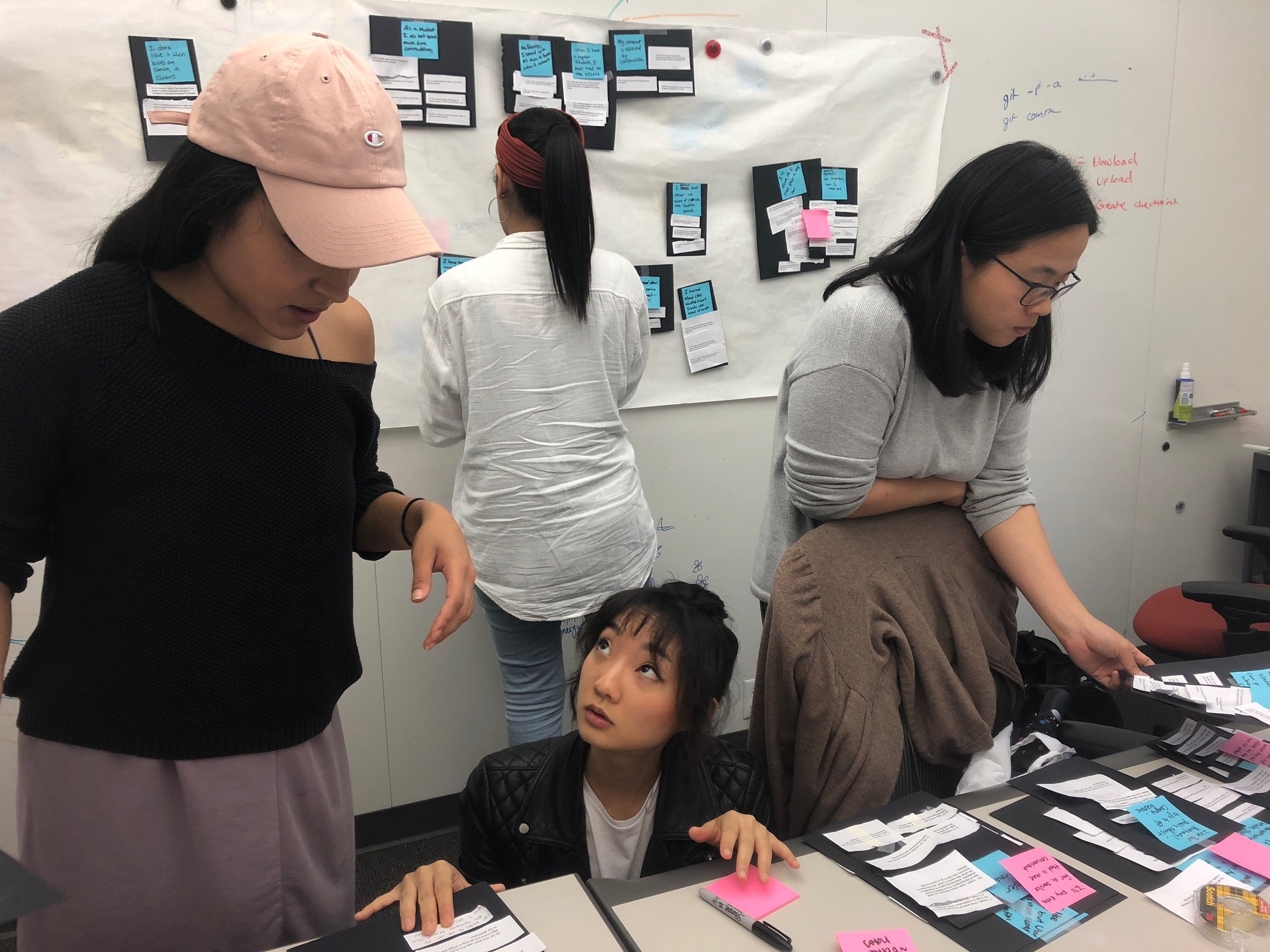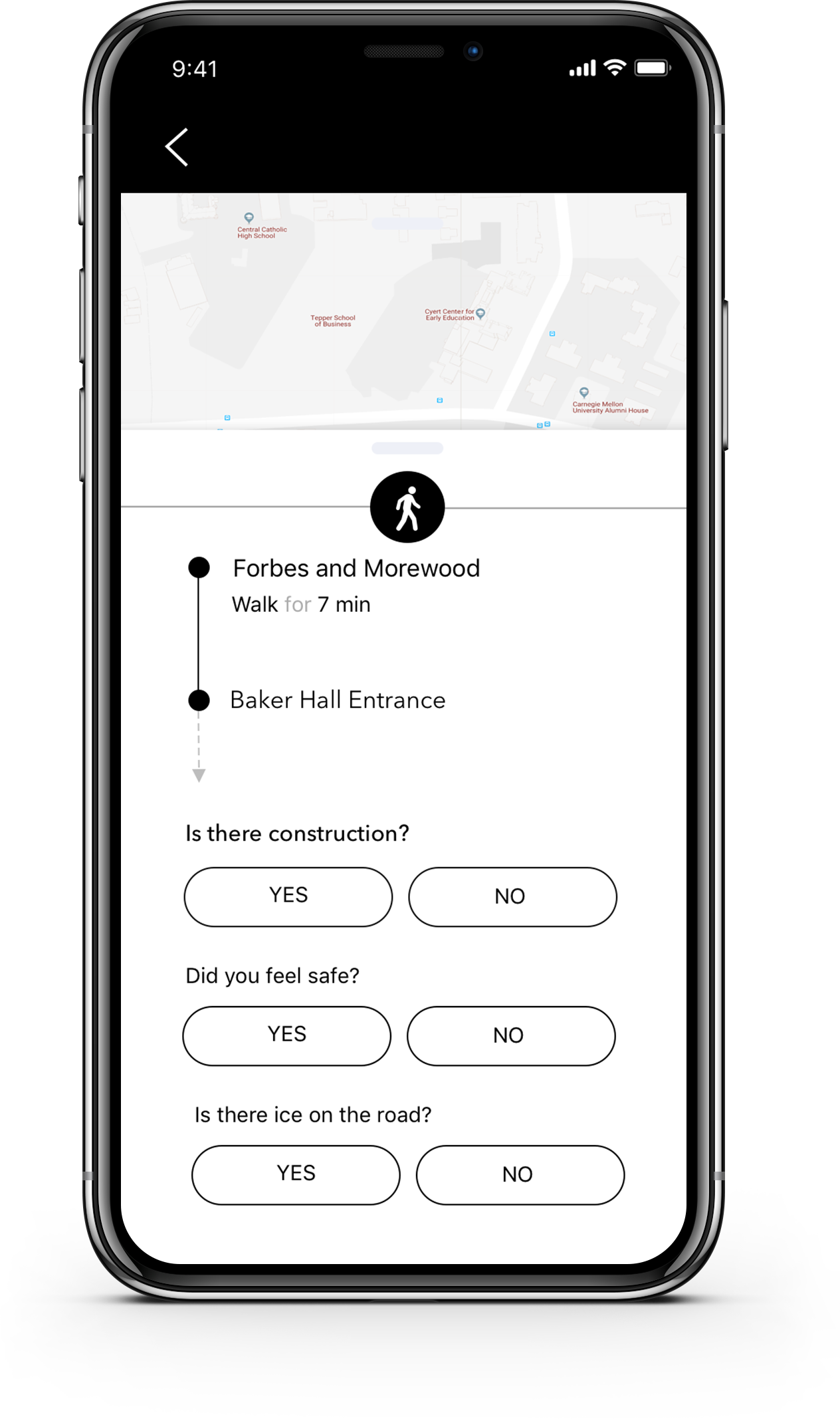Overview
Hermes
Helping CMU students get where they’re going, fast.
Fall 2018 // 10 weeks
CMU Course, UX Research
Team Project // 5 people
Problem
Graduate students at Carnegie Mellon University want to get to class as quickly as possible, but they often have difficulty navigating campus due to unpredictable buses, construction, and CMU’s confusing multi-level layout. It takes a while to learn about the best shortcuts and buses to take, as this information is not readily available on any current transportation platforms.
Solution
For the isolated CMU graduate student who doesn’t have access to word-of-mouth information about CMU-specific transit options, Hermes provides an easy way to optimize transportation routes to/around campus. The application leverages user-friendly crowdsourcing to incorporate information about CMU’s shuttle service, campus layout & amenities, and indoor shortcuts to class currently not provided by other applications. With Hermes, students don’t have to waste time comparing shortcuts or wondering if their shuttle will be late; they can get where they’re going, fast.
Methods
Contextual Inquiry, Interviews, Speed-Dating, Paper Prototyping, Think Alouds
Tools
Sketch, Invision
Role
I worked in a 5 person team, contributing mainly to interaction design and data analysis.
KEY FEATURE 1
Indoor NavigationWithin-building navigation paired with information about CMU-specific transit options helps students navigate CMU’s tricky campus and get to their classroom door as quickly as possible.
KEY FEATURE 2
Crowdsourcing Made EasyWe used simple in-trip surveys to minimize effort busy students have to put in to report incidents. This data, in conjunction with implicit data collected about popular within-building shortcuts, is used to provide optimized routes to students.
Background
DESIGN ROADMAP
“It took me a while to learn how to get around campus. The buses, the buildings...it’s all so confusing, and I couldn’t find information anywhere.”
PROJECT CONTEXT
How might we improve the CMU transportation system to better serve student needs?
This is primarily a UX research project. It was created for a class called User Centered Research and Evaluation to address the goals of the Carnegie Mellon Graduate Student Assembly (GSA). The GSA came to us with a problem: how might they improve transportation options for CMU students, making them useful safe, reliable, and accessible to all? Specifically, the GSA wanted to focus on the CMU shuttle system, a free transit option to campus for all students.
After conducting extensive research using both generative and evaluative methods, my team realized that students, specifically isolated and overworked graduate students, wanted to get to, from, and around campus as quickly as possible to maximize efficiency—Carnegie Mellon students have large workloads. However, they were lacking information about campus transportation options, as transit apps were not meeting their needs. We created a design artifact to address this problem: Hermes, a CMU-specific mobile application to get students to and around campus in as little time as possible.
Process
1. Background Research
A MULTI-METHOD APPROACH
In the early phases of this project, we engaged in multiple methodologies to understand the state of student transportation on CMU campus from many angles. We conducted experiential research (riding the shuttle service, observing students moving around campus, and visiting the CMU transit website/app), reviewed statistics related to fallen ridership levels, performed Think-Alouds with CMU-specific mobile applications, and created creating flow models, sequence models, and affinity diagrams from pre-existing interviews with stakeholders in the CMU shuttle system.
TAKEAWAYS
Experiential & Secondary Research
Inconspicuous CMU shuttle stop sign
We began looking over CMU transit statistics and noting our own experiences with transportation around CMU campus. This helped us develop a baseline understanding the problem space. We found that:
Students are dissatisfied with the shuttle service. Ridership statistics showed that the number of CMU student shuttle riders has been declining over the last couple of years, and, based on app reviews, social media posts, and observation, students generally think the shuttle services aren’t meeting their needs.
It is difficult to find information about CMU transit options. Our experiential research suggested that this may partly due to how difficult it is to find information about the shuttle and escort services.
Flow/Sequence Modeling
Flow and sequence models based on pre-existing interviews were created to gain a shared understanding of shuttle system processes and identify breakdowns. It revealed that:
The CMU shuttle can be unpredictable. This is a major breakdown in student transportation services; shuttles often skip stops and arrive late.
Students prioritize speed above cost. We found that students are choosing quicker modes of transportation like Uber over the CMU shuttle despite the fact that shuttle fees are included in their tuition.
Sequence model for a CMU shuttle driver.
Flow Model depicting how resources and relationships are distributed in relation to the CMU shuttle service.
Think-Alouds
We also conducted Think-Alouds with Ridesystems and Tiramisu—two mobile applications designed to track public transit options relevant to CMU. This was done to identify any student needs not currently being met by CMU-specific navigation tools .Despite the intentions of each application, we found that:
CMU-specific apps do not allow for intuitive and holistic route planning. Students had to switch between multiple apps, such as Google Maps, in order to complete many of the Think-Aloud tasks. This part of our research also revealed that these applications tend to be centered on the specific mode of transportation rather than focusing on getting the user from point A to point B.
Think-Aloud with Tiramisu
NARROWING OUR FOCUS
Our background research brought up many issues with CMU transportation services that helped us begin to narrow our focus. Our research showed that there is no one website or application where students can get all relevant information related to CMU specific transportation, which may be the cause of declining shuttle ridership levels. Moving forward, we decided to dig deeper into the problem of lack of centralized transportation information for CMU students.
2. Generative Methods
IMMERSING OURSELVES IN THE PROBLEM SPACE
Once we understood the general state of student transportation, we began conducting generative, exploratory research so we could further refine our problem definition and uncover new student needs. Research methods used in this phase included contextual inquiries, semi-structured interviews, and Think-Alouds with competitor apps like Waze to gain an on-the-ground understanding of what student needs were/were not being met by current solutions. We chose Waze because Waze incorporates crowdsourcing, a feature we thought might be useful to notify students of bus status and on-campus construction.
We conducted two rounds of semi-structured interviews and contextual inquiries with CMU undergrads and graduate students, each time refining our problem. We analyzed both using affinity diagramming.
Constructing affinity diagram
Final affinity diagram
Discussing data groupings for affinity diagram
Think-Aloud with Waze app
INSIGHTS FROM GENERATIVE RESEARCH
In analyzing the think-aloud, semi-structured interview, and contextual inquiry data, my team came to the following insights. We used these insights in the next phase of the design process to define a specific problem statement.
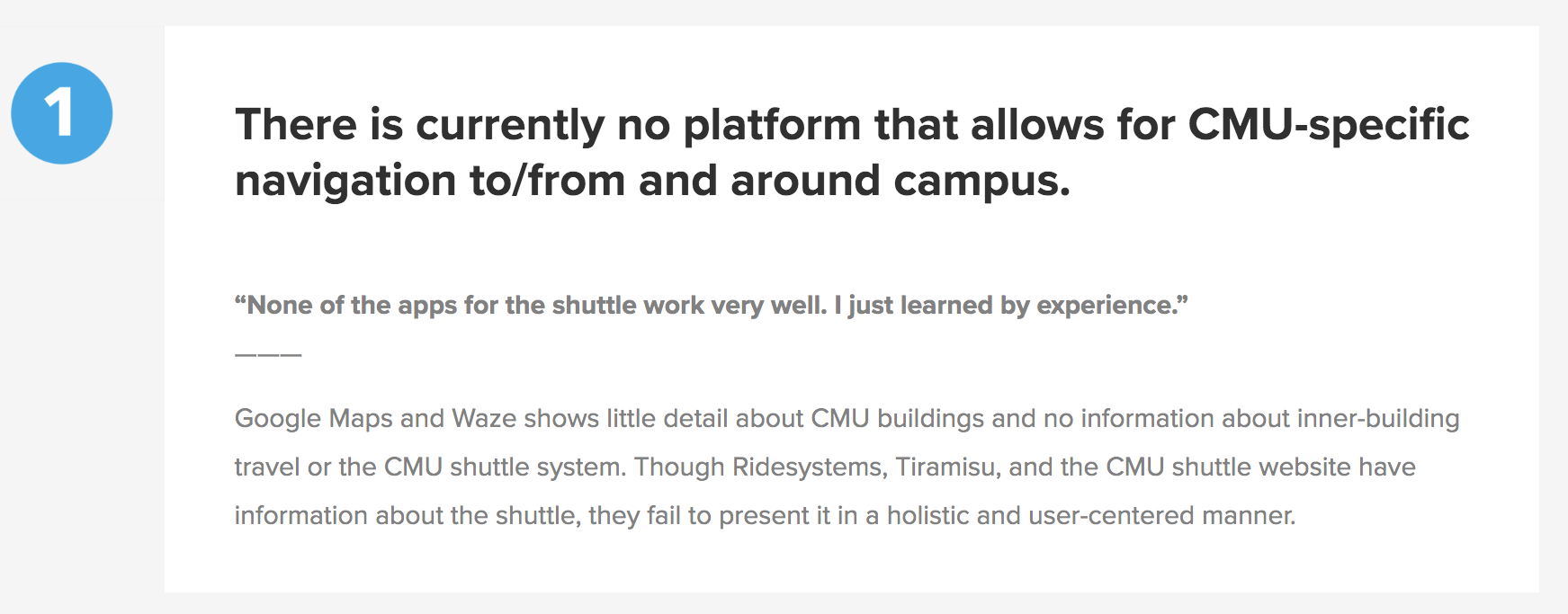

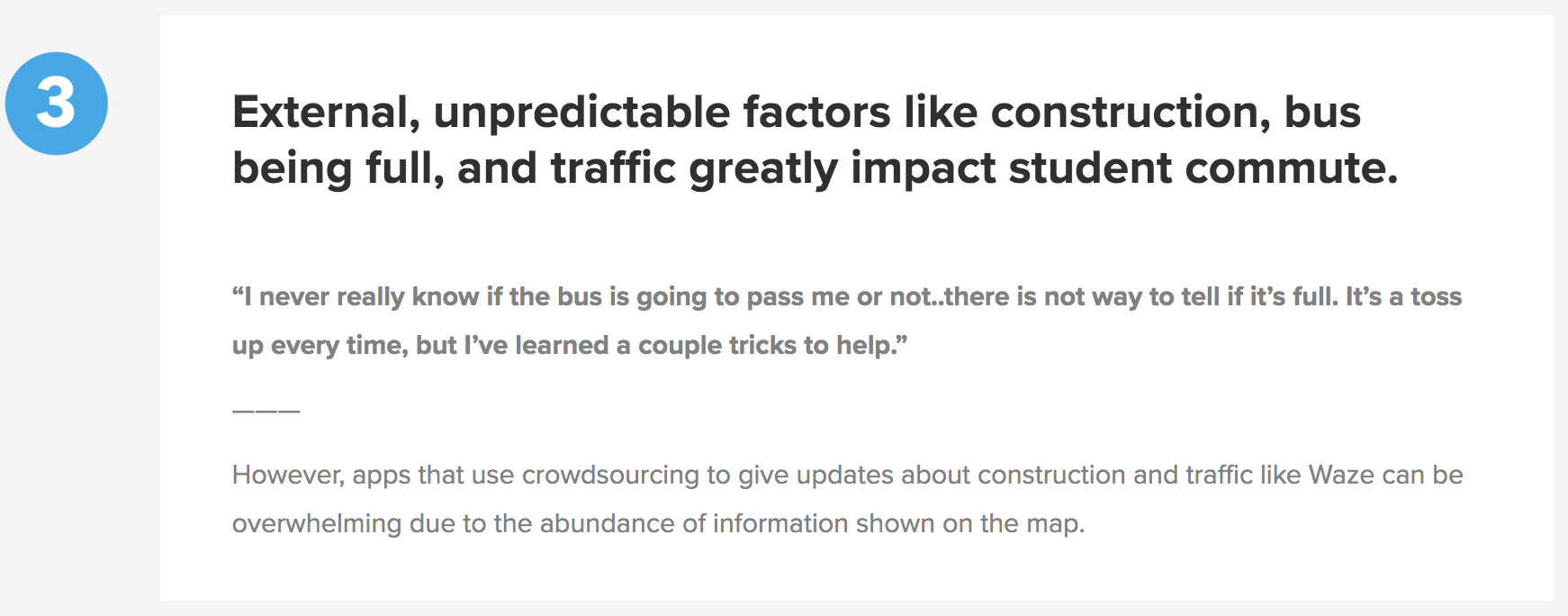
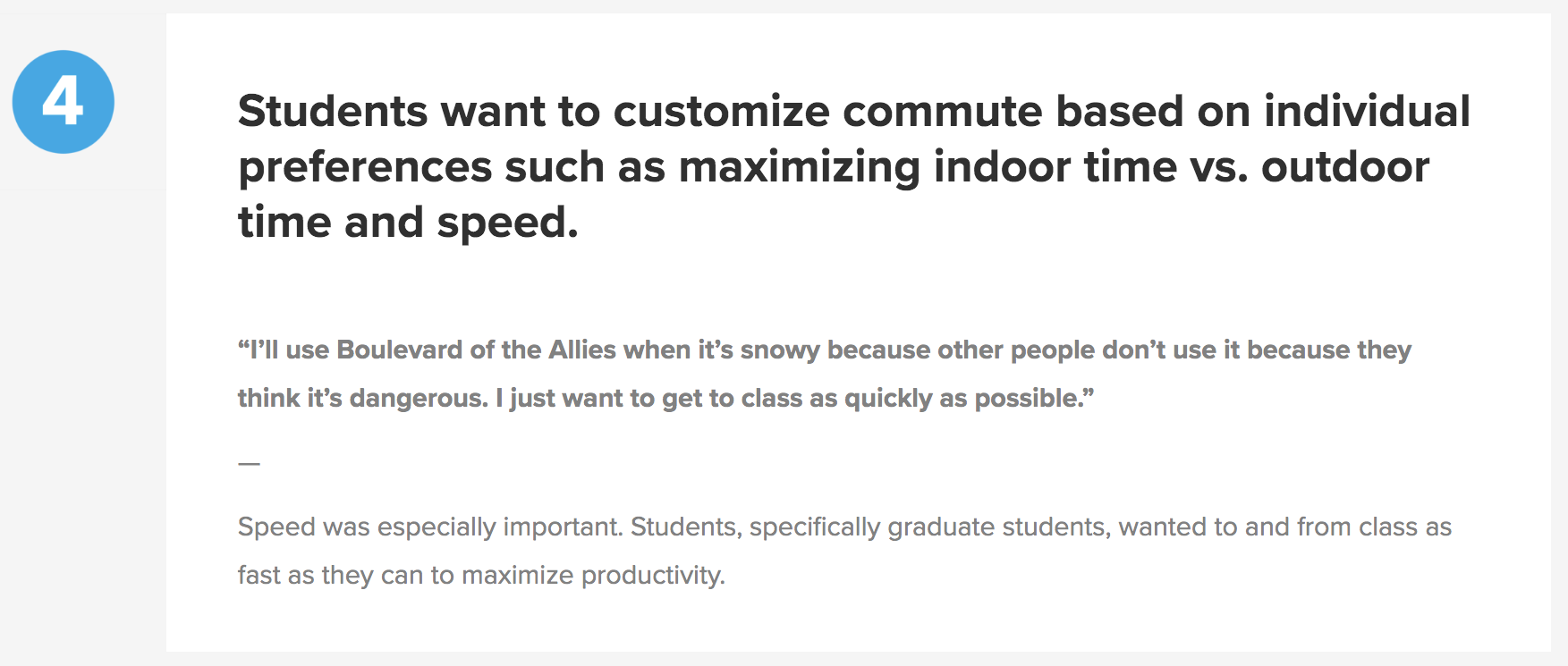
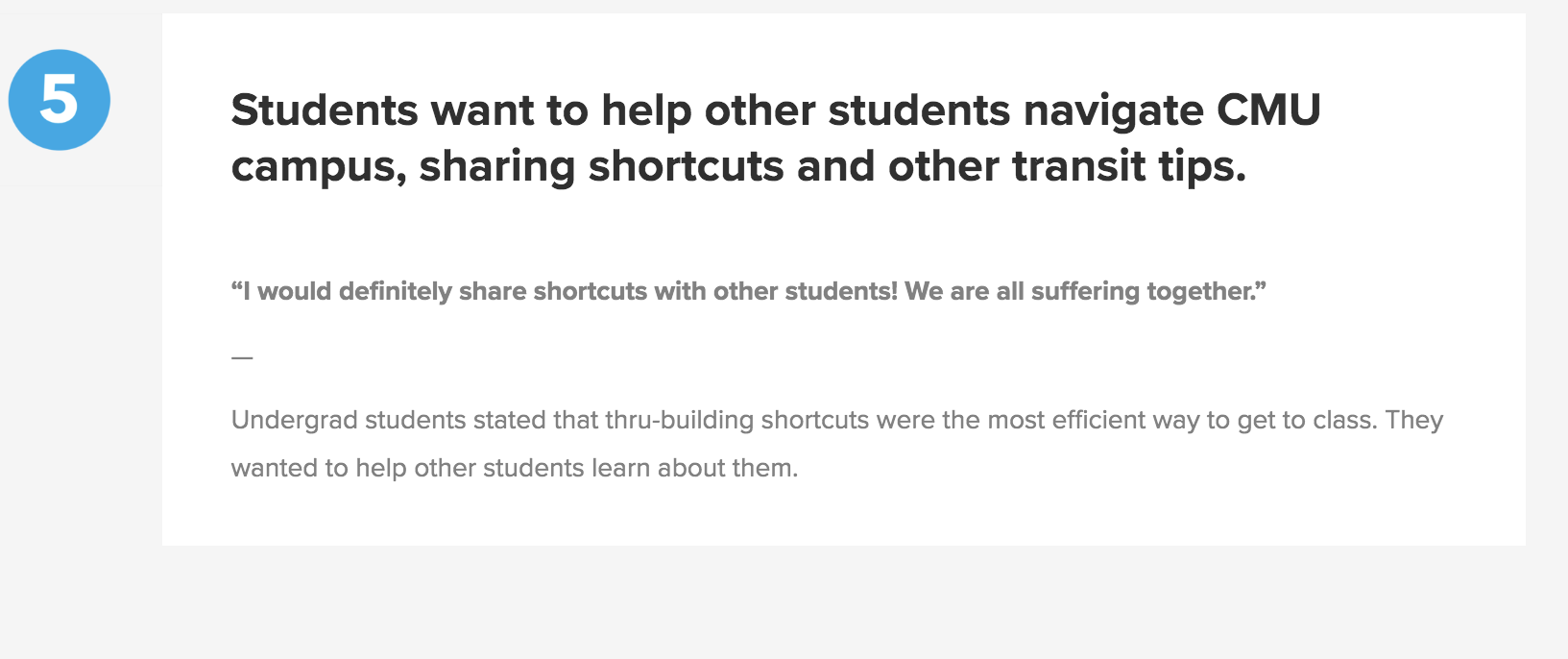
3. Problem Definition & Ideation
DEFINING THE PROBLEM
Our insights from generative research phase helped us refine our problem statement as follows:
Problem Statement
New students and graduate students on CMU campus want to get to class as quickly as possible, but they tend to be more isolated and do not have access to word of mouth information about best transit options. It can take up to a couple years to learn about the best thru-building shortcuts and buses to take, as this information is not readily available on any current transportation platforms.
IDEATION
After defined the problem, we began ideating, highlighting specific needs we wanted to address and potential ways to address those needs. We started this process by “walking the wall”: hanging up the data gathered from generative research in our studio and pasting sticky notes with breakdowns, needs, questions, and design ideas on them. Walking the Wall helped my team re-immersing ourselves in the data and the analysis we performed on it.
Notes from walking the wall
Identified needs (in blue) and potential solutions to meet those needs (in red).
SPEED DATING WITH STORYBOARDS
We used “speed dating” to test if uncovered user needs (and potential solutions) were valid. This research method tows the line between evaluative and generative, and involves showing users several storyboards highlighting user needs and seeing how they respond to each. We created several storyboards, each highlighting a specific need and hinting at a potential solution, and tested them with 5 users.
Sample Storyboards
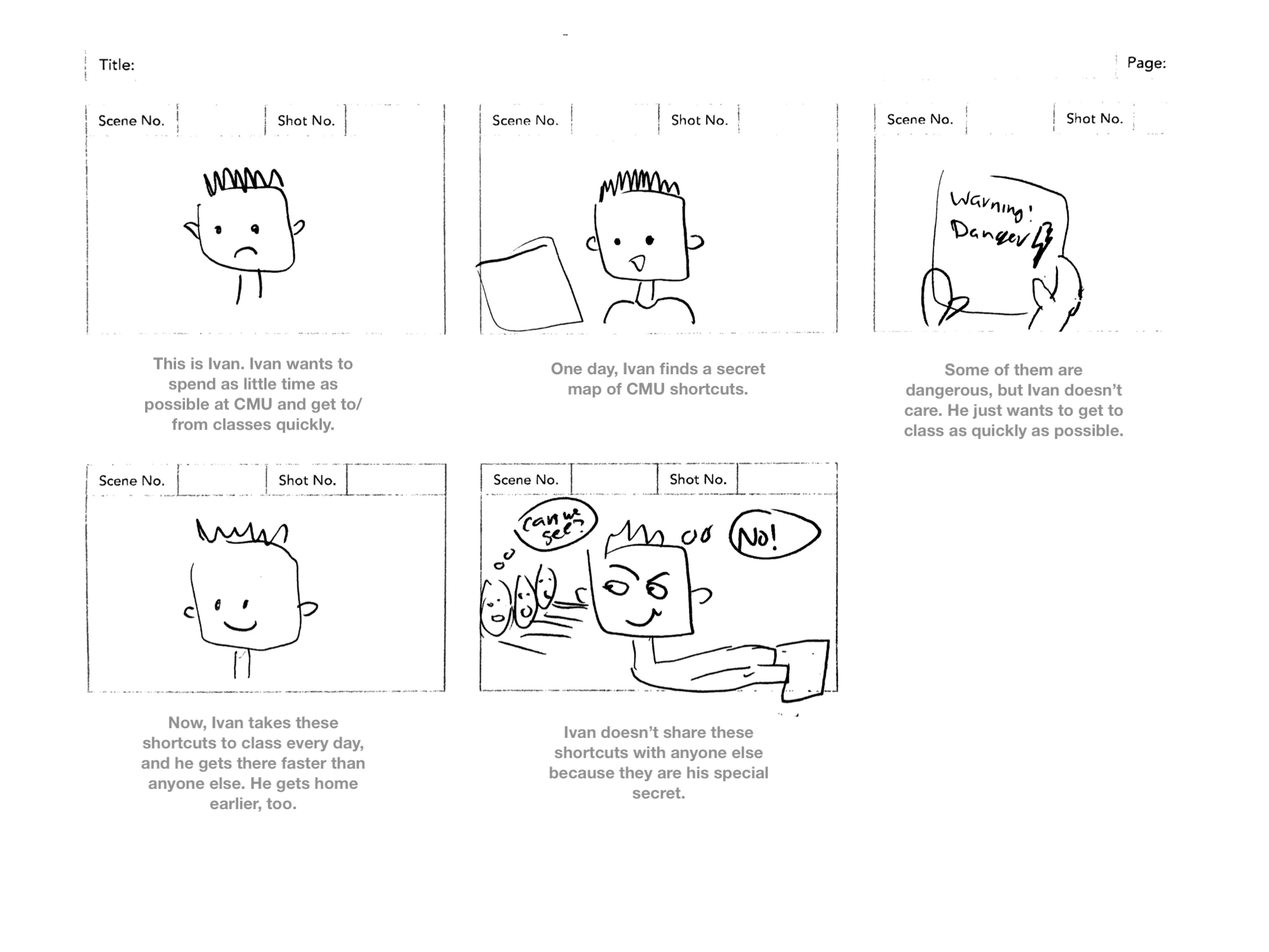
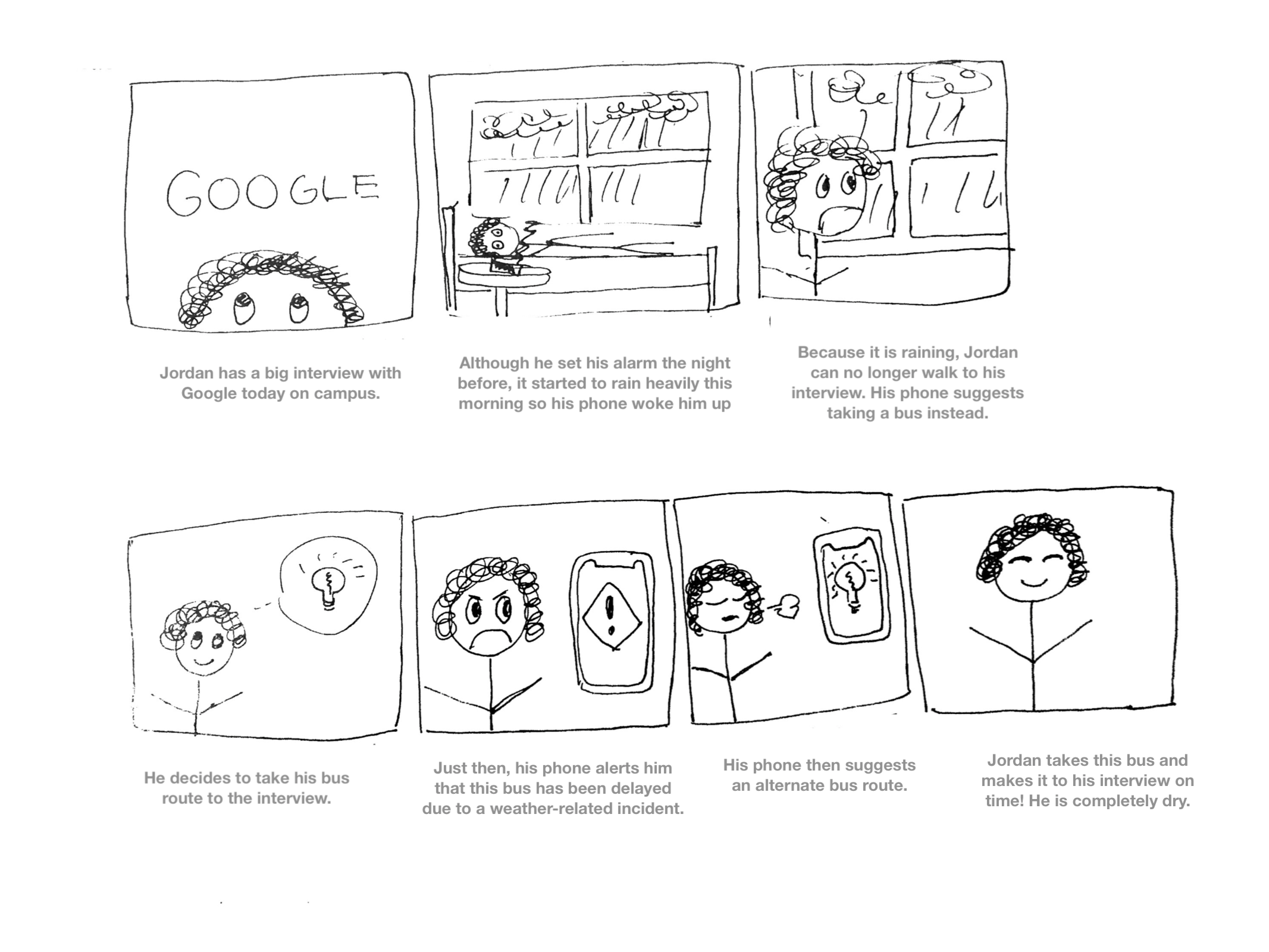
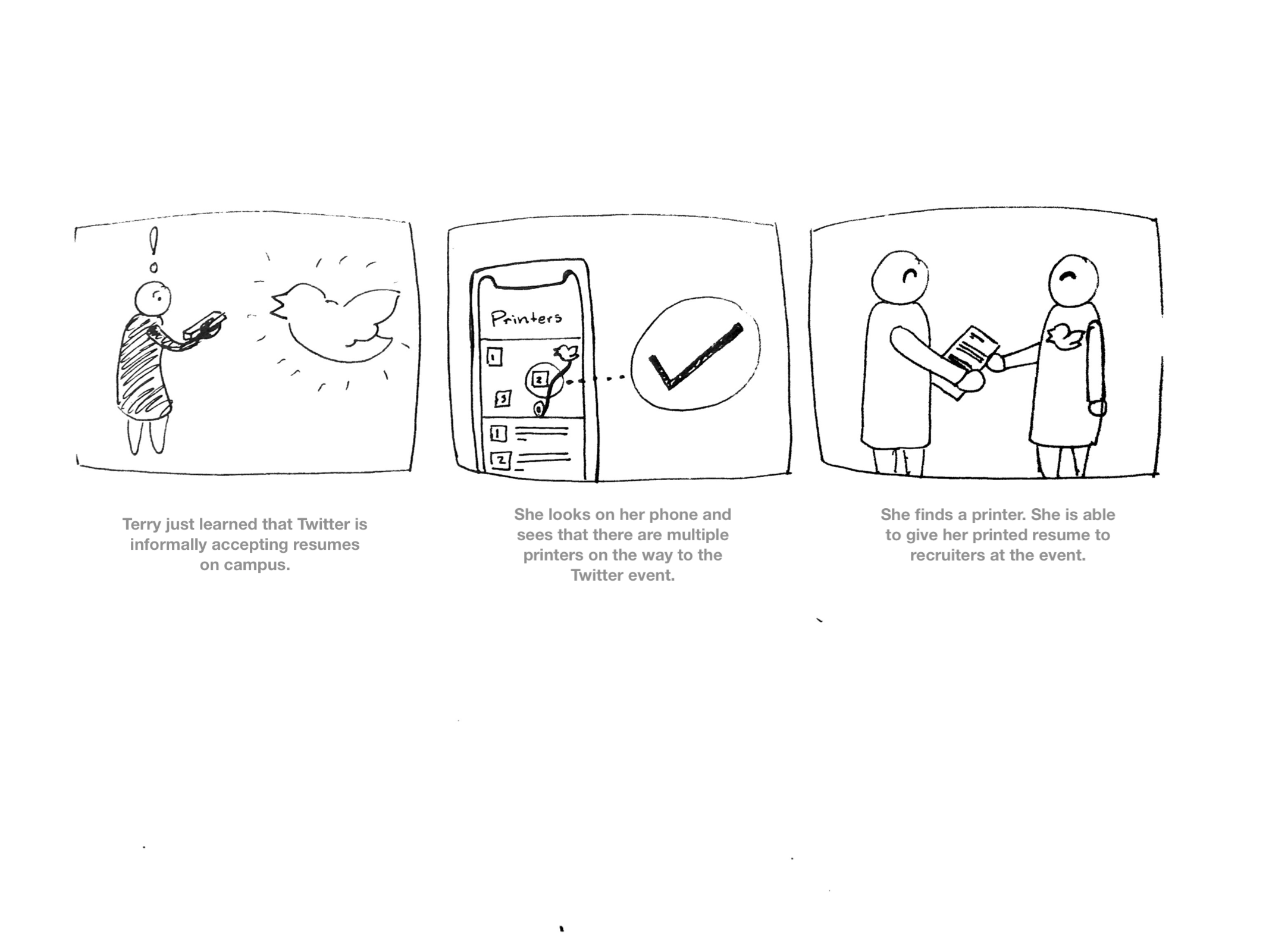
Takeaways from Speed Dating
This research method validated the need for a solution that provides holistic route planning and incorporates information about within-building navigation (“shortcuts”) for graduate students so they can get to class as quickly as possible. We were also able to discover new needs, such as the desire to avoid unsafe/sketchy areas.
4. Prototype & Evaluate
Based on our research, we decided to create a transportation app that consolidated information about CMU-relevant transportation in one place, including public transit, CMU shuttle system, and walking directions for within-building navigation. By focusing holistic route planning, we aimed to help students get from their doorstep to their classroom as quickly as possible. We explored using crowdsourcing to students could share information with others about late/full buses, construction, unsafe areas on campus, and popular thru-building shortcuts.
The evaluative methods we used included Think-Alouds on digital and paper prototypes.
LO-FI PROTOTYPE: A SOCIAL NAVIGATION EXPERIENCE
We began with paper prototyping to get feedback on functionality and usefulness of our solution. We scanned the paper prototypes and linked them in InVision, testing with 5 CMU students.
Our first iteration attempted to make navigation a social experience, as our research suggested students wanted to help each other find the best routes. The app encouraged users to record and share within-building shortcuts with each other so they could get to class more quickly, and included an “activity” page where they could see how they contributed to the community.
Paper Prototype Screens
Insights from Paper Prototyping
Conducting Think-Alouds with the paper prototypes provided feedback on user flow/features, accessibility, and discoverability of the UI. We included a semi-structured interview after the Think-Aloud to learn more about the user experience and opinions about specific features. We arrived at the following insights from user testing:
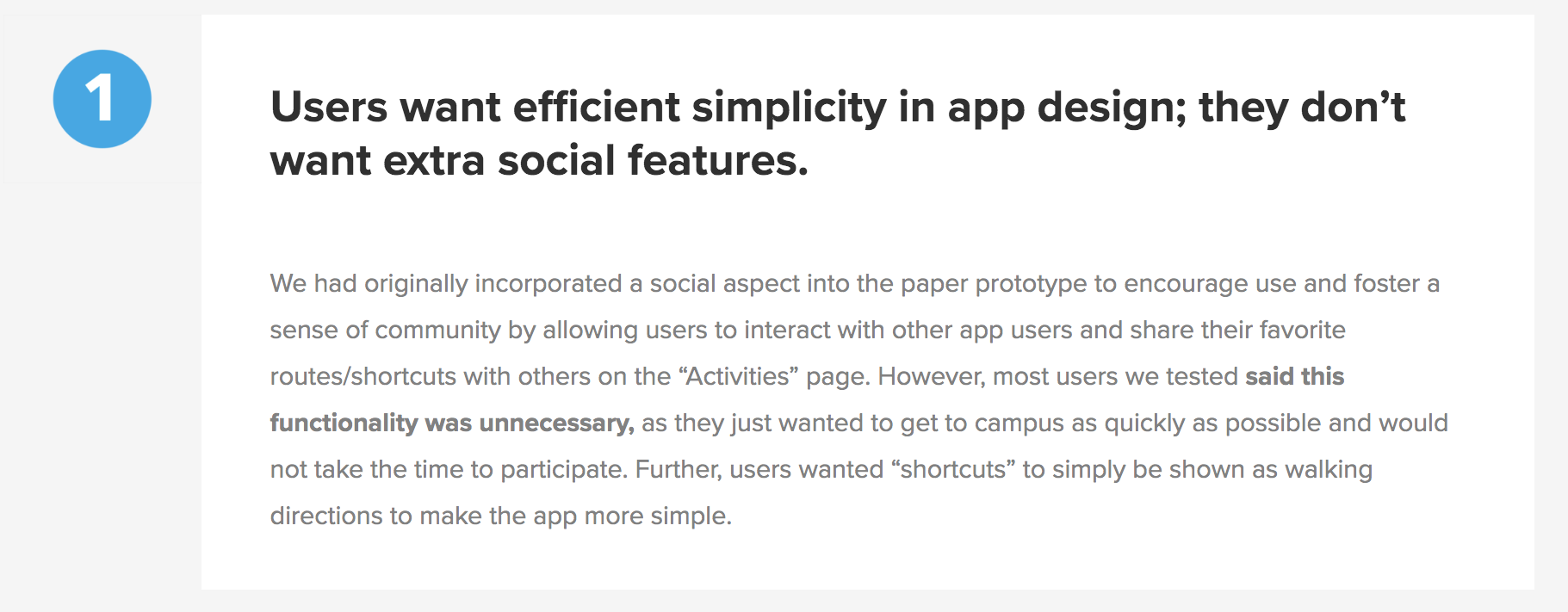

MID-FI PROTOTYPE: LESS SOCIAL, MORE PRACTICAL
Taking user feedback into account, we iterated to a mid-fi solution. This iteration eliminated some of the unnecessary social features and made crowdsourcing easier for users. We conducted one more Think-Aloud and semi-structured interview on the mid-fi iteration.
Wireframe
Please note that much of the UI here is taken from external resources and is not of our own design.
Takeaways from Mid-Fi Testing
User testing gave us valuable feedback about user flow and app features. In particular, we discovered that the crowdsourcing and class schedule interactions needed to be made even more convenient/simple for users, as students were busy and valued efficiency above all else.
Final Design
5. Refined Prototype & Demo
HERMES: CMU NAVIGATION AT GOD SPEED
It’s hard to get to class quickly at CMU.
Students, specifically graduate students at CMU, are extremely busy and have no time to waste; they want to find the quickest and most convenient form of transportation to and from campus. However, no apps currently meet their needs; Google Maps and Waze do not have campus-specific transit information about CMU buildings and the shuttle service, and CMU-specific navigation apps like RideSystems are poorly designed.
Helping students get where they’re going, fast.
Hermes is the solution to the above issues. Hermes is a user-friendly, CMU-specific transit application that provides holistic route planning to get users to their campus destination as fast as possible. With this application, students no longer have to visit multiple websites and applications to find the best route to class; rather, information about CMU shuttle, public buses, and within-building amenities/ shortcuts are all consolidated in Hermes. A simple, survey-based method of crowdsourcing is used to give users information about external factors like construction and full buses that may impact their commute.
Because students prioritize speed, we named our application “Hermes” (fastest of greek gods) and made our logo in the shape of a wing to symbolize swiftness.
UI Design & Wireframe
Features
EASY ACCESS TO CMU-SPECIFIC INFORMATION
CMU buildings are labeled on the home screen map, a feature other transit apps like Google Maps do not have. Users can view their classes and campus buildings directly from the home screen.
If we implemented this application, we would leverage Google APIs for the map and navigation functionality, while also inputting new data specific to CMU’s campus.
CAMPUS BUILDING DETAILS
Users are given direct access to building directions & information, including details about amenities like dining halls and lounges. They can swipe between cards to see different campus buildings for easy access, or click on pins.
Rationale: Users expressed a desire for this information because they often had trouble locating buildings and finding amenities like lounges and printers. Including it gives Hermes a competitive advantage over popular transit apps like Google Maps, Apple Maps, and Waze.
SYNCING CLASSES
Users can view their current class schedule and find the best route to class directly from the home page. Class schedules sync onto the app from their school account, which users are prompted to log into upon first use.
Rationale: This way, students don’t have to spend the time uploading their course schedule manually, as most said:
“I wouldn’t spend the time inputting my class schedule. I already do that on my calendar apps.”
HOLISTIC, CONSOLIDATED ROUTE INFORMATION
Information about all CMU relevant transportation, including public buses, CMU shuttles, and within-building navigation is included in the app for easy and efficient access, consolidating information found across many transit applications. Users can search for a particular classroom and receive directions on how to get there directly from their current location, using multiple forms of transportation.
Rationale: This allows users, especially those new to campus, to efficiently find the optimal route to their destination without having to switch between multiple apps.
WITHIN-BUILDING NAVIGATION
We provide indoor navigation so users can cut through campus to get to their destination more quickly. If we were to implement this application, we would leverage Google Indoor, a within-building navigation system that requires business owners to upload floor plans. Over time, we would aggregate data about popular indoor shortcuts to optimize route suggestions.
Rationale: In our research, we found that students often take shortcuts within buildings to reduce commute time, but it takes a long time to learn about the best ones; some isolated graduate students never learn. With our app, users have shortcut information at their fingertips.
CROWDSOURCING FOR FAST, OBSTACLE-FREE TRAVEL
We ask users survey questions during their commute for crowdsourcing purposes. If we implemented this solution, the collected data would be used to optimize student routes to avoid construction or unsafe areas based on previous rider feedback, notifying students if any incidents have occurred on their route and redirect them to a new route if necessary. We also aim to use crowdsourcing to predict bus trends (i.e. “the bus is normally full at this time.”) because the CMU shuttles don’t have technical capabilities to track bus capacity status.
Rationale: We decided to include a simple, within-trip survey rather than having the users manually input incidents without prompts, like Waze does. We did this because, in our testing, users indicated they would not go through the extra effort to report incidents unprompted.
“I want to help, but I honestly wouldn’t report anything if the app didn’t ask me to.”
PRESENTATION
We showcased our refined InVision prototype and research at a poster presentation session. HCI faculty, students, and members of the GSA (our client) were present. Our solution was well received by the GSA.
REFLECTION
If I had more time, I would…
Explore more specific ways to integrate collected data into the app. As mentioned in the design section, we intend to collect crowdsourced data about route obstacles and bus status in addition to implicit data about popular indoor shortcuts to provide optimized routes to CMU students. My team discussed that if we had more time and could actually build out the application, we would love to evaluate quality and quantity of data and experiment with more specific ways to integrate it.
Explore emerging tech for indoor navigation. Indoor navigation is relatively new on the tech scene, but holds a lot of promise; as mentioned in the design section, technology like Google Indoor is now being used to provide indoor navigation in select areas. If we had more time, I would have loved to explore using other new technology solutions for indoor navigation, such as AR or Microsoft’s Path Guide. This would be a whole other project in itself!
If I could go back in time, I would…
Begin designing sooner. We spent a lot of time doing research before design started. This was in part because the project was created for a UX research course that emphasized the research portion of the design process. However, in future projects I would like to take action sooner, turning insights into testable prototypes instead of waiting until later phases to begin designing. This would have expedited the project and helped us create a more built-out final prototype.
Break the rules more. We engaged in very specific, structured research methods laid out by class instructors. Though these were useful, I think we could have changed and tailored some of these methods to our specific project needs in order to get more of what we wanted out of them. In the future, I plan to use the “rules” for research methods as guidelines, breaking them when necessary for my project.
Want to view more project materials?







